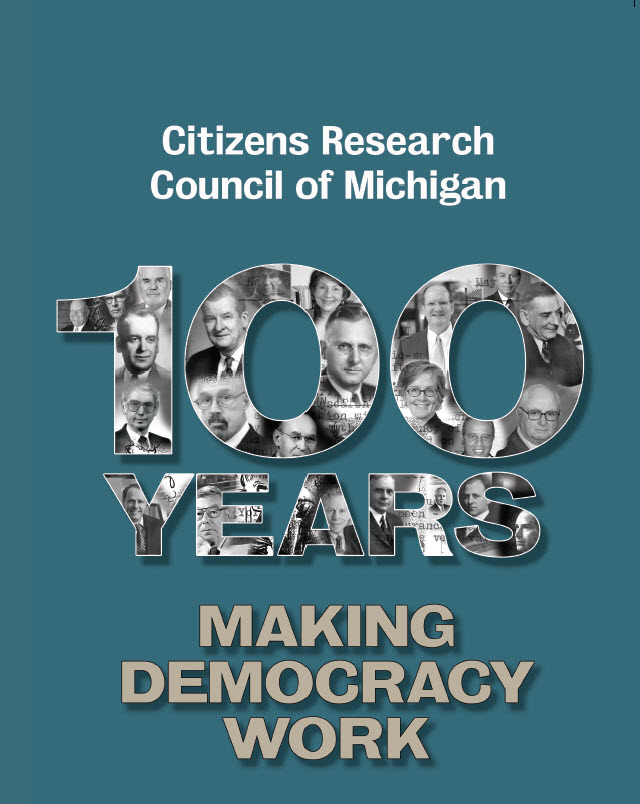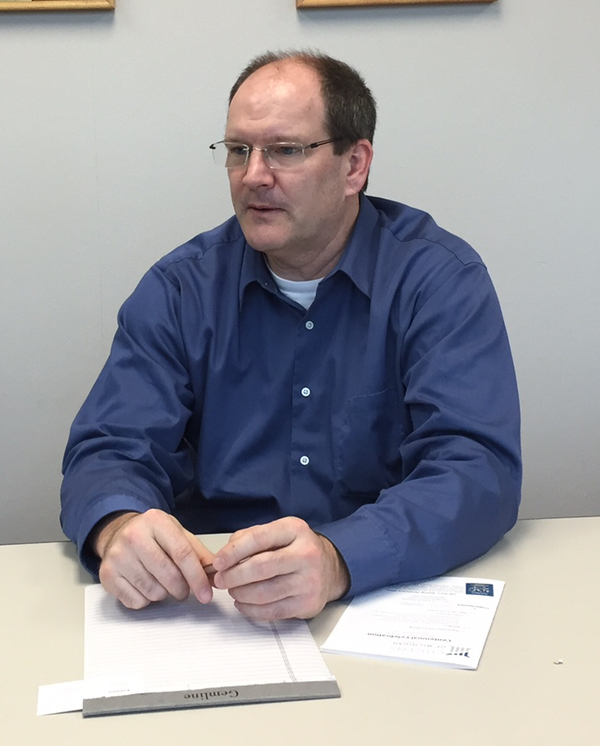Citizens Research Council marks 100 years of putting government under its microscope
The Citizens Research Council of Michigan is hardly a household name in most of the state. With fewer than 10 full-time employees, housed in unremarkable office buildings in Livonia and Lansing, its low profile belies its impact in state policy circles.
Poised to observe its centennial on Wednesday (April 13), even the celebration is low-key – lunches and receptions in Detroit, Lansing and Grand Rapids, and a fundraising auction of items no flashier than restaurant gift certificates, tickets to sporting events and scented candles.
But make no mistake: The CRC has had a hand in scores of state-level issues, and its work consistently informs the deliberations of lawmakers, policy wonks, journalists and others looking for nonpartisan, fact-based, unbiased analyses of governmental intentions and outcomes in Michigan.
CRC analysts had a hand in rewriting the state’s constitution in the early ‘60s. They helped reform its recall-election law in 2012. And they informed the public during the 2012 general election, when the ballot was crowded with citizen-petition ballot initiatives, covering topics from the emergency-manager law to the Ambassador Bridge.
One other element of the centennial observance, a history written by CRC president emeritus Earl Ryan, lays out the ground covered by the group, founded to bring good government to the fast-growing city of Detroit at the dawn of the automotive era.
Immigrants, from points domestic and abroad, were flooding into Michigan in search of work, stressing everything from sewer systems to housing to transit. New, urgent concerns about public health and education were asserting themselves, and municipal governments were unequipped to handle them.
The Progressive era, which encompassed the turn of the 19th to 20th centuries, had already produced at least a partial solution: “Governmental research,” private organizations that would analyze public entities and propose alternative, modified or new structures, based on a dispassionate review of facts. New York City already had produced the New York Bureau of Municipal Research, founded in 1906.
The New York bureau attracted wealthy patrons, in part because its early work rocked the Tammany Hall patronage system then in place. It was only natural that the idea would spread.
A young man named Lent Upson, an Illinois native, interned at the New York organization in 1911 and founded a similar group in Dayton a year later. But, Ryan writes, the chance to start another in the fast-growing metropolis of Detroit was enough to lure him to Michigan, and the Detroit Bureau of Governmental Research, which later became the CRC, was founded in 1916.
Ryan recounts one of the most pressing municipal concerns of the time: What material to use for sewer construction?
Until then, “sewers were built from brick, which was a local industry,” Ryan said in a recent interview. But brick and mortar deteriorates quickly underground, and the Detroit Bureau recommended they instead be constructed of less-expensive concrete, and what’s more, that the contracts be opened to competitive bidding. It was an entirely new way of doing a city’s business, and competitive bidding was added to the 1918 city charter.
Upson was the author of what might be called the CRC’s founding philosophy, now found on the organization’s home page: “The right to criticize government is also an obligation to know what you are talking about.”
Widening reputation, then peril
The bureau’s earliest work was concentrated on concepts we now take for granted. The city charter adopted in 1918 was full of bureau recommendations, including “reducing the Common Council from 42 members elected by ward to nine elected at large; the initiative, referendum and recall; establishment of the Detroit Institute of Arts; modern budgeting, accounting and purchasing; and competitive bidding,” Ryan writes.
As the city grew, so did the bureau’s reputation. When, in 1925, an African-American doctor named Ossian Sweet bought a house in a white neighborhood, it touched off a mob attack of the home, and a person in the crowd was killed by gunfire (events described in the book, “Arc of Justice,” which won a 2004 National Book Award). In response, then-Detroit mayor John Smith convened a city commission, which in turn commissioned a comprehensive report on the state of blacks in the city, on the condition the research be overseen by the bureau. The resulting study, “The Negro in Detroit,” was a product of its time and attitudes, but was modern in its recognition of racism, poverty, police brutality and lack of education as the root causes of difficult race relations in the city.
But growth, not only of the bureau but of every person and institution in Detroit, was soon to smash into a wall ‒ the Great Depression. The downturn curtailed its fiscal support so much that it was forced to seek shelter under the umbrella of what was then called Wayne University, when it was folded into the newly formed School of Public Administration and Social Work.
It was during this period that the bureau began to consider expanding its focus to the entire state. A statewide public expenditure survey began that work, but it would be 1951 before the name changed to the Citizens Research Council of Michigan ‒ the new center of attention (although Detroit remained a subspecialty).
With new territory to survey, the CRC began to examine not just government itself, but related institutions ‒ Jackson Prison, the Michigan Children’s Institute, which oversees wards of the state, Wayne County General Hospital and tuberculosis facilities around the state. But it wasn’t until the Constitutional Convention of 1961-62 that CRC put its stamp on the state as a whole.
As part of that convention, which would become the biggest single project in its history, the CRC issued papers analyzing the constitution and related issues; most notably, it recommended consolidation and streamlining of state government.
“The most significant change was the consolidation of state functions into no more than 20 departments,” said Ryan. “Before that, there were 140 departments. No governor can have that kind of span of control and make it work.”
Not all recommendations were adopted, however. The convention rejected shortening the state ballot, and allowed for “the curious process of selecting justices of the Michigan Supreme Court via partisan nomination and nonpartisan election,” Ryan writes. But in general, the “con-con” was a process that has “CRC’s fingerprints all over it,” he said.
In subsequent years, the staff examined the issues that come with growth and change, including taxation, consolidation, intergovernmental cooperation, regionalism and more. And as the state fell upon hard times and stopped growing, the CRC looked at that, too.
“A recurring theme with us is, state finances get in trouble, CRC analyzes and points the way out,” said Eric Lupher, current president.
Paul Hillegonds, former speaker of the Michigan House of Representatives, now CEO of the Michigan Health Endowment Fund, said he has valued CRD’s work for years.
“As a legislator, I would always share CRC's ballot proposal analyses with constituents,” he said via email. “When engaged in policy development in public, private and nonprofit roles, I have relied on CRC studies and analyses. Why? Because of the quality, depth and integrity of CRC research – research that has served Michigan well for a century.”
A more perilous 21st-century landscape
A century always brings unanticipated changes, and those have affected the organization, too. It has more competition in influencing policymakers, from for-profit data analysts like Public Sector Consultants and Anderson Economic Group, to think tanks like the Mackinac Center for Public Policy and academics at the state’s universities. Globalism has changed the focus of the businesses that support the CRC, and the board of directors has fewer CEOs and more vice presidents.
“A hundred years ago, the state was our playground,” said Ryan. “Our niche has shrunk.”
Other changes have been more welcome. Where once only a handful of influencers received its printed reports, the Internet has expanded its audience exponentially. In 2012, when the November ballot was heavy with petition-driven constitutional amendment questions, the CRC analyses of the six issues were heavily consulted.
“(The paper on the renewable energy question) got 180,000 downloads,” said Lupher. “That’s amazing.”
But with competition has come an old conundrum, which Ryan calls that of broad vs. narrow appeal. Acknowledging that “being the best-kept secret in the state” is “not a long-term recipe for success,” Ryan harkens back to Upson’s belief that criticizing government requires the critic to know what they’re talking about, “and most people don’t know what they’re talking about,” Ryan said.
“Take a discussion of pension funding, for example. You talk about actuarial vs. present value, and the average person’s eyes will glaze over,” Ryan said. “But you’re talking about billions of taxpayer dollars. Someone has to pay attention.”
The Citizens Research Council of Michigan’s centennial book is available for a minimum $20 donation. Request a copy by calling the CRC’s Livonia office at 734-542-8001 or by emailing crcmich@crcmich.org.
See what new members are saying about why they donated to Bridge Michigan:
- “In order for this information to be accurate and unbiased it must be underwritten by its readers, not by special interests.” - Larry S.
- “Not many other media sources report on the topics Bridge does.” - Susan B.
- “Your journalism is outstanding and rare these days.” - Mark S.
If you want to ensure the future of nonpartisan, nonprofit Michigan journalism, please become a member today. You, too, will be asked why you donated and maybe we'll feature your quote next time!


 The CRC’s 84-page centennial history, written by Earl Ryan, is available from the organization for a $20 donation.
The CRC’s 84-page centennial history, written by Earl Ryan, is available from the organization for a $20 donation. Eric Lupher is the eighth president in the Citizens Research Council’s 100-year history. (Bridge photo by David Zeman)
Eric Lupher is the eighth president in the Citizens Research Council’s 100-year history. (Bridge photo by David Zeman)